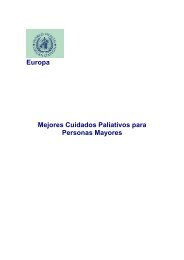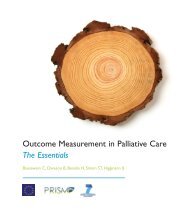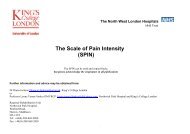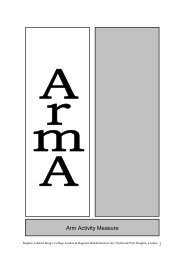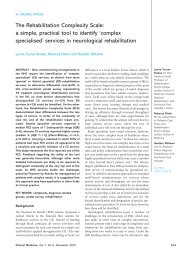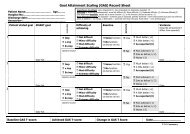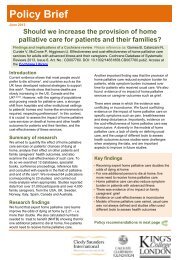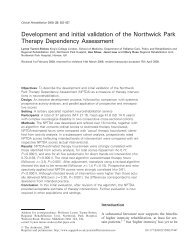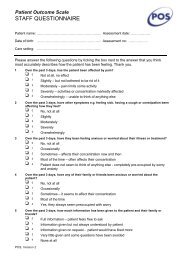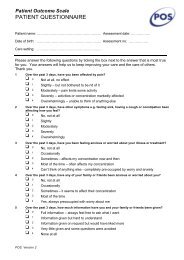2004 - 2007 - Cicely Saunders Institute - King's College London
2004 - 2007 - Cicely Saunders Institute - King's College London
2004 - 2007 - Cicely Saunders Institute - King's College London
Create successful ePaper yourself
Turn your PDF publications into a flip-book with our unique Google optimized e-Paper software.
tasks. Some patients, especially early in the recovery<br />
phase, may expect to regain voluntary control of their<br />
arm and hand following relief of spasticity, but for more<br />
severe and longer-standing paralysis, the goals for<br />
intervention tend to be ‘passive function’ such as<br />
improving the ease of caring for the person – for<br />
example making it easier to maintain hygiene or to put<br />
the arm through a sleeve while dressing. A systematic<br />
review of the literature revealed no suitable tools<br />
currently available for measuring both passive and active<br />
functions of the upper limb that would properly assess<br />
the functional benefits of managing upper limb<br />
spasticity, so we have developed a new tool called the<br />
ArMA, which is now undergoing evaluation.<br />
Patient-centred outcomes in rehabilitation - the<br />
use of Goal Attainment Scaling (GAS)<br />
Goal attainment scaling (GAS) was first introduced in the<br />
1960s as a tool for evaluating individualised outcomes in<br />
complex interventions in patients with learning disabilities,<br />
but it has only relatively recently gained popularity<br />
outside in other fields. One of the major challenges for<br />
outcome measurement in rehabilitation is the wide<br />
variety of different goals that patients may have for their<br />
rehabilitation programme. GAS absorbs much of this<br />
variation within the process of goal setting, making it a<br />
potentially valuable tool for this context. Moreover, a<br />
patient-centred instrument that specifically evaluates the<br />
outcomes that are important to the patient and their<br />
family provides an important perspective that is not<br />
included in most standardised measures of outcome.<br />
In our preliminary application of GAS as a measure for<br />
assessing focal changes during the management of<br />
upper limb spasticity (see above) Ashford and Turner-<br />
Stokes found that GAS provided a useful measure of<br />
functional gains in response to treatment, and was more<br />
sensitive than global measures such as the Barthel<br />
Index 208 . Further work is underway to address the<br />
benefits of GAS over currently applied standardised<br />
outcome measures in our wider rehabilitation<br />
programme.<br />
18




